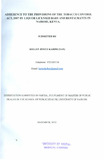| dc.description.abstract | Introduction: Tobacco use is the single most preventable cause of death and disease in the world today. Globally, tobacco related diseases kill over 6 million people every year. Tobacco smoking was estimated to be at 40% in men and 9% in women as of the year 2006 and more than 80% of all smokers are men. In 2004, second hand smoke was estimated.to cause about 600,000 deaths per year and majority of these deaths occur in the middle and low income countries. Second hand smoke contributed to 1 % of total disease burden. A key intervention in reducing the burden of disease attributable to tobacco use, is protecting people from exposure to second. hand smoke.
The workplace is a primary source of SHSexposure among adult non- smokers, Bars and restaurants workershav'e higher levels of exposure than other occupations. The magnitude of exposure to tobacco smoke is not yet determined but can be measured. The Tobacco Control Act, 2007was passed by the Kenyan parliament in August, 2007 to guide tobacco activities in the country. Its implementation is guided by the National Tobacco Control Action Plan 2010-2015.
This study seeks to assess the level of adherence to the provisions of the Act related to exposure to tobacco smoke by the liquor licensed bars and restaurants, since they are among the environments where exposure takes place.
General objective: To assess adherence to the provisions of the Tobacco Control Act, 2007 by liquor licensed bars and restaurants in Nairobi.
Methodology: The study design was a descriptive cross-sectional study. The study was conducted among bars and restaurants in Nairobi's Westlands District. Information on adherence to the Tobacco Control Act, 2007 was be obtained by trained interviewers.
Quantitative data was collected from the managers and/or owners of the bars and restaurants participating in the study using interviewer administered structured questionnaires. Quantitative data was also obtained by observation using a checklist. Key informant interviews were conducted among managers and/or owners of the bars and restaurants as well as' among officials in institutions responsible for enforcement of the Tobacco
Control Act, 2007 in Nairobi. A key informant guide was used in this case.
Data management and analysis: Data was entered into Epi- info for data management. Clean data was then exported to SPSS version 17 for analysis. Graphs and tables were used to summarize data and measures 'ofstrength of association between the: dependent and independent variables were tested using Pearson's chi square.
Potential application: The study sheds light on the level of awareness of the Tobacco control provisions, if they are being adhered to and the barriers that the managers of the bars and restaurants face during their effort to ensure protection of the workers and customers from exposure to second hand smoke.
Ethical considerations: Ethical approval was sought form ethics and research committee. Ethical provisions for studies involving human subjects were strictly adhered to. Approval to conduct the study in the proposed area of study was obtained from the District Commissioner's office in the District.
Results and discussions: The adherence to the provisions of the Act was measured using 4 indicators. Smoking takes place, people smoking at the time of interview, display of 'no smoking' signs, and availability of designated smoking areas. Smoking took place in establishments operating as bars as well as establishments operating as bars and restaurants. Smoking took place in about 85% of the establishments operating as bars and in 85%, of establishments operating as bars and restaurants.
Of all the establishments studied, 49%, of the establishment operating as bars had displayed 'no smoking' signs in their premises. Iii the establishments operating as bars and restaurants, 58%,had displayed 'no smoking' signs. Designated smoking areas were found in.45%, of establishments operating as bars, and in 62%, of the establishments operating as bars and restaurants.
The level of awareness of the TCA, 2007 was high 76%. Barriers to adherence were found to be fear of lack of business, people being stubborn and also
lack of proper implementation of policy. Of all the establishments studied, 49%, reported to have some kind of workplace policy on tobacco use. In about 67%, establishments, the managers reported that employees entered the smoking area to attend to clients.
Conclusion and recommendations: Level of awareness is high but adherence is low. The level of awareness of the harmful health effects of tobacco use was also high. The general feeling was that, if the Tobacco Control Act, 2007 is well implemented it could be the best tool in protecting the workers in the bars and restaurants.
A study that will therefore establish the disconnect between the high level of awareness and the low level of adherence need to be conducted to ensure the protection of the general public from effects of exposure to tobacco smoke. The ministry of health therefore must come out strongly in protecting the health of the public, since tobacco is a major risk factor in the development of noncommunicable diseases. All parties concerned with the implementation ands enforcement of the
TCA, 2007, including managers and or owners of the bars and restaurants should work together in ensuring smooth implementationof the Act. The role ofthe Tobacco industry in Tobacco Control should be clear to avoid conflict of interest. | en_US |

